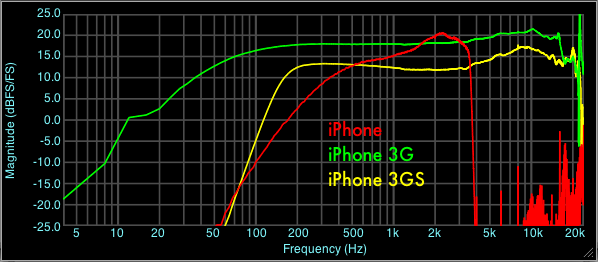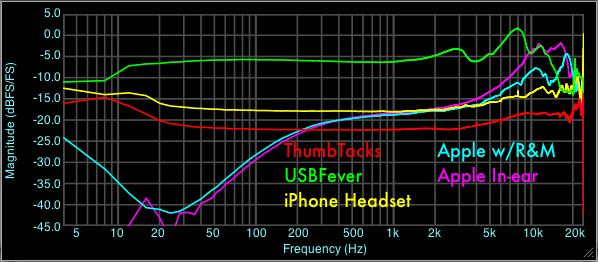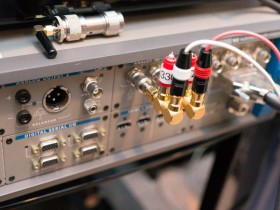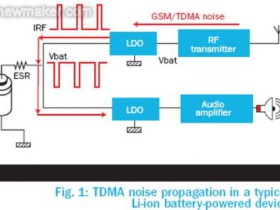- A+
With the advent of sound level meter apps for the iPhone OS (of which SoundMeter was the first) people began to ask, “How flat is the frequency response of the iPhone’s microphone?” Early testing indicated that the built-in microphone of the original iPhone was not a good candidate for sound level measurements, but that the iPhone’s headset microphone enjoyed a fairly flat response. Since then, additional iPhone models have arrived on the scene, each with its own set of weaknesses with respect to microphone frequency response. Additional Apple and third party headset microphones have also been introduced.
At long last, some relevant frequency response measurements are presented here for the benefit of those who would really like to “see” how flat a particular microphone is. These results have implications on the use of certain microphones for making sound level measurements, as well as on the use of these microphones for spectral analysis in which relative amplitudes need to be determined with some degree of accuracy.
The following measurements were made relative to a Type 1 precision microphone in a fairly quiet room. These measurements were not made in an anechoic chamber and although the coherence was very good across the audio band, the measurement error is non-negligible at high frequencies, because of diffraction effects.
Built-in Microphones

Built-in iPhone Microphone Frequency Response Comparison
As I have often said, “The built-in microphone of the original iPhone is not recommended for sound level measurements.” Now, you can really see what I mean. Interestingly, the built-in microphone of the iPhone 3GS isn’t recommended, either, unless you don’t care about frequency content below 200 Hz. This behavior is consistent with the headset input frequency response of the iPhone 3GS (I suspect that the built-in microphone signal goes through the same high-pass filter that gets applied to the headset input). The iPhone 3G microphone’s response is clearly the best of the bunch, but its low end rolls off by 15 dB or more at 20 Hz. Not surprisingly, none of the iPhone models rivals a lab-grade sound level meter with its built-in microphone, but either of the 3G models can potentially give you a decent ball-park estimate of the current sound level, although the low frequencies will be de-emphasized.
Headset Microphones
The goal, here was not to measure every headset microphone on the market, but to take a look at some of the more common options. These measurements were made of each microphone’s electrical output, so they do not include the response of any iPhone input or output circuitry. The microphones included in these measurements are:
- SwitchEasy ThumbTacks microphone
- USBFever Mini Microphone
- iPhone Headset Microphone (included with each iPhone)
- Apple Earphones with Remote and Mic
- Apple In-ear Headphones with Remote and Mic

iPhone Headset Microphone Frequency Response Comparison
In the world of headset microphones (at least those that are presented, here), the official iPhone headset microphone and the SwitchEasy ThumbTacks microphone win the day. The USBFever microphone also exhibits a flat response between 20 Hz and 2 kHz, although its response appears to break up more severely by the time it gets up to 10 kHz. In light of recent headset input frequency response measurements, the best case scenario for inexpensive sound level measurement might be to use the ThumbTacks microphone with the original iPhone.
These results are also interesting, in that they strongly suggest that the newer Apple headsets, which are designed primarily for iPods, shouldn’t be used for sound level measurements, either. Their response certainly seems to follow an apparent trend with Apple’s microphone-related circuitry to de-emphasize low frequencies.
It may be important to keep in mind that the goal, here, is to see what makes sense in terms of using iPhone OS devices as inexpensive, portable sound level and spectrum analysis tools. Obviously, there was never an expectation that the iPhone’s inexpensive microphones would perform in a manner consistent with precision measurement mics that are (justafiably) much more expensive. It is possible to connect such high-end microphones to an iPhone, though (via the dock connector)–more on that, later…



